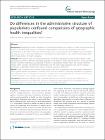| dc.contributor.author | JACKSON, ANDREW | |
| dc.date.accessioned | 2010-10-14T16:59:37Z | |
| dc.date.available | 2010-10-14T16:59:37Z | |
| dc.date.issued | 2010 | |
| dc.date.submitted | 2010 | en |
| dc.identifier.citation | Jackson AL, Davies CA, Leyland AH, Do differences in the administrative structure of populations confound comparisons of geographic health inequalities?, BMC medical research methodology, 10, 1, 2010, 74 | en |
| dc.identifier.other | Y | |
| dc.identifier.uri | http://hdl.handle.net/2262/41050 | |
| dc.description | PUBLISHED | en |
| dc.description.abstract | Background: Geographical health inequalities are naturally described by the variation in health outcomes between
areas (e.g. mortality rates). However, comparisons made between countries are hampered by our lack of
understanding of the effect of the size of administrative units, and in particular the modifiable areal unit problem.
Our objective was to assess how differences in geographic and administrative units used for disseminating data
affect the description of health inequalities.
Methods: Retrospective study of standard populations and deaths aggregated by administrative regions within
20 European countries, 1990-1991. Estimated populations and deaths in males aged 0-64 were in 5 year age bands.
Poisson multilevel modelling was conducted of deaths as standardised mortality ratios. The variation between
regions within countries was tested for relationships with the mean region population size and the unequal
distribution of populations within each country measured using Gini coefficients.
Results: There is evidence that countries whose regions vary more in population size show greater variation and
hence greater apparent inequalities in mortality counts. The Gini coefficient, measuring inequalities in population
size, ranged from 0.1 to 0.5 between countries; an increase of 0.1 was accompanied by a 12-14% increase in the
standard deviation of the mortality rates between regions within a country.
Conclusions: Apparently differing health inequalities between two countries may be due to differences in
geographical structure per se, rather than having any underlying epidemiological cause. Inequalities may be
inherently greater in countries whose regions are more unequally populated. | en |
| dc.format.extent | 74 | en |
| dc.language.iso | en | en |
| dc.relation.ispartofseries | BMC medical research methodology; | |
| dc.relation.ispartofseries | 10; | |
| dc.relation.ispartofseries | 1; | |
| dc.rights | Y | en |
| dc.subject | population health | en |
| dc.subject | public health | en |
| dc.title | Do differences in the administrative structure of populations confound comparisons of geographic health inequalities? | en |
| dc.type | Journal Article | en |
| dc.type.supercollection | scholarly_publications | en |
| dc.type.supercollection | refereed_publications | en |
| dc.identifier.peoplefinderurl | http://people.tcd.ie/jacksoan | |
| dc.identifier.rssinternalid | 68207 | |
| dc.identifier.rssuri | http://www.biomedcentral.com/1471-2288/10/74 | en |




